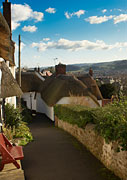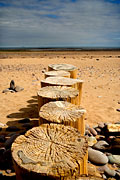 In the 15th century Minehead was still a mainly agricultural area. However, the position of the settlement, on the north coast of Somerset, between Exmoor and the sea, meant that the fishing industry soon developed. For hundreds of years afterwards, herring was the staple catch of the local fishermen. At one time, the parish church had a beacon, both to guide travellers on Exmoor into town and to help ships into the harbour.
In the 15th century Minehead was still a mainly agricultural area. However, the position of the settlement, on the north coast of Somerset, between Exmoor and the sea, meant that the fishing industry soon developed. For hundreds of years afterwards, herring was the staple catch of the local fishermen. At one time, the parish church had a beacon, both to guide travellers on Exmoor into town and to help ships into the harbour.
In spite of constant problems with the sea-battered harbour walls and some silting in the river estuary, trade developed rapidly from the 16th century onwards. Much of the trade was with Ireland, Virginia and the West Indies. Cargoes included various textiles, coal and livestock. Wines were also imported from France and Spain.
A local estate-owning family, the Luttrells of Dunster Castle, built a stone harbour in Minehead in the early 17th century. This was further strengthened with great boulders in 1682. The town continued to prosper during the rest of the century, both from shipping and the local woollen industry. However, trade began to decline during the 18th century.
The new large ships demanded larger ports, such as Bristol and Liverpool. These were also in better locations for world trading. Around this time, the local textile industry went into decline, as a result of competition with northern industrialised factories. The final straw was when many buildings were destroyed by fire in 1791.
Shortly before this, Minehead had begun to develop as a holiday destination. This was partially because doctors were beginning to advocate bathing in sea water as a remedy for many ailments. It also owed something to the presence of many of the romantic poets of the time. Several poems mention the area such as “The Rime of the Ancient Mariner” by Samuel Taylor Coleridge, who lived nearby at Nether Stowey. The wooded bluffs above Minehead are said to be the Hermit’s abode described in the poem.
Another story tells that Coleridge once woke up, probably from an opium dream, with a complete poem composed in his head. He started to write “In Xanadu did Kublai Khan…” but was disturbed by a knock on the door, when part way through the poem. When the caller had gone, Coleridge was unable to complete the rest of the poem as he had already forgotten it.
Coleridge and William Wordsworth, who lived at nearby Alfoxden for a time, often took long walks at night, on the coast and over the nearby hills. This led to local rumours that they were spying for the French, especially as the group to which they belonged were known to be fairly radical. The Government investigated but came to the conclusion that they were merely poets.
The lovely scenery of this area is said to have inspired the words of the hymn “All Things Bright and Beautiful”, by Cecil Frances Alexander. A much later son of Minehead was the science fiction writer, Arthur C, Clarke, who was born here in 1917.
As Minehead developed as a holiday resort, the town and the occupations of the people changed to accommodate this new function. When the railways opened, the number of visitors increased and the town continues to be a popular tourist destination today.
 The harbour, beach and promenade are all sheltered by the heather-clad hills inland of the town. North Hill is one of these and offers good views of both the town and the Bristol Channel. Minehead has a superb setting between the Exmoor National Park and the coast. Originally there were three separate settlements here but these have merged into one.
The harbour, beach and promenade are all sheltered by the heather-clad hills inland of the town. North Hill is one of these and offers good views of both the town and the Bristol Channel. Minehead has a superb setting between the Exmoor National Park and the coast. Originally there were three separate settlements here but these have merged into one.
Older parts of town still have thatched cottages and narrow alleyways. Church Steps, below St Michael’s Church on North Hill, is a good example. There are some lovely parks in the town, particularly Blenheim Gardens where concerts are held on Saturday and Sunday afternoons during the summer. Minehead has a number of speciality shops in addition to the high street chains.
The picturesque harbour has an old stone pier from where it is possible to take Bristol Channel cruises and local fishing trips. There is a seafront railway station from which it is possible to take steam trains along the coast as far as Bishops Lydeard, about twenty miles away. There are several steam festivals each year and there is attractive lighting on the seafront in the evenings.
Minehead has a wide range of entertainment and sports facilities. These include cinema, leisure centres and a fun fair. It also has many cafés, bars and restaurants and a wide choice of holiday accommodation. There is also a wide choice of excellent walks from town into the lovely Exmoor countryside. Dunkery Beacon, Exmoor’s highest point, is close to Minehead and red deer can often be seen as well as shaggy Exmoor ponies. There are many pony-trekking centres in the area with well-trained horses on which is an ideal way to explore the moors. The South West Coast Path starts on the seafront here and follows the coast round Lands End in Cornwall and as far as Poole Harbour in Dorset.
Dunster Castle is just two miles from Minehead. It is a wonderful example of a fortified castle and is open to visitors. Its exciting history has many links to that of Minehead itself. The village of Dunster is worth visiting for its many attractions including the Yarn Market, the Doll’s Museum, and St George’s Church with its magnificent rood screen.



